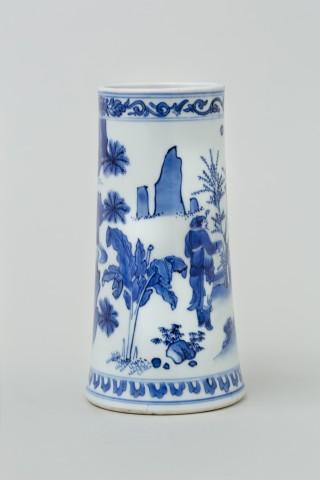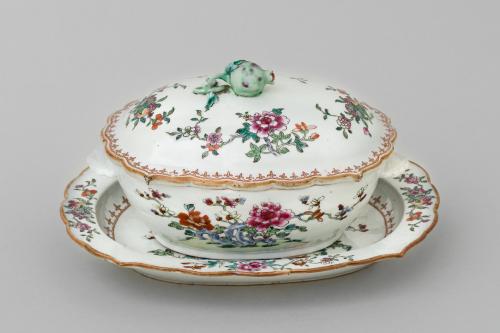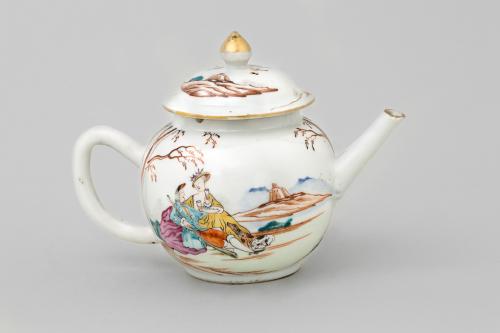


Price on application
This object is eligible for a Certificate of BADA Provenance
The BADA Standard
- Since 1918, BADA has been the leading association for the antiques and fine art trade
- Members are elected for their knowledge, integrity and quality of stock
- Our clients are protected by BADA’s code of conduct
- Our dealers’ membership is reviewed and renewed annually
- Bada.org is a non-profit site: clients deal directly with members and they pay no hidden fees
Of tall tapering cylindrical shape and applied with a loop handle, painted in shades of underglaze blue with a scene set in a terraced garden of a dignitary being presented with books by a male figure dressed in short robes, trees and mountain peaks in the background, the sun/moon in the sky, a plantain, stylised rockwork and swirling clouds dividing the scene, all set in between a band at the top with scroll-work and a band around the foot with pendant lappets, the handle painted with a flowering branch.
LITERATURE
There is a tankard of similar form in the Queen's Bedroom at Kensington Palace, as part of the Royal Collection. It is attributed Ming Period, c.1635-1645 (collection number RCIN 1060). This tankard is illustrated in John Ayers' volume 'Chinese and Japanese Works of Art in the Collection of Her Majesty The Queen, 2016, C&J p.238
Compare with a similar tankard illustrated in Seventeenth Century Jingdezhen Porcelain from the Shanghai Museum and the Butler Collections, Shanghai Museum 2006, no. 121 and another similar example from the Hermitage Museum illustrated in Hermitage, The State Hermitage Editorial Board: Chinese Export Art in the Hermitage Museum, Late 16th - 19th centuries,published by the Hermitage Museum 2003, pl. 4, p. 21, a further example is in the Collection Ernest Grandidier at the Musee national des Arts asiatiques-Guimet, Paris, no G 2678.
Two tankards of similar decoration are in the collection of the British Museum (museum number Franks.155), illustrated in Jessica Harrison-Hall, Ming Ceramics in the British Museum, the British Museum press, 2001, pl. 12:11, 12:12, pp. 358-359, Harrison-Hall discusses the shape of this type of tankard and we quote: "Tankards of this type are modelled after Dutch stoneware or wooden prototypes and were made exclusively for export to Europe with Chinese 'transitional'-style figurative designs. In 1635 painted turned-wooden models were dispatched to China via the governors of Fort Zeelandia in Taiwan to be copied, and in 1636 stoneware snelletjes, made in Cologne, were also sent to Jingdezhen…In addition to the Dutch records and items with dated [silver] mounts, tankards of this type are also accurately rendered in still-life oil paintings of the mid seventeenth century. For example a still-life oil painting by Jan van de Velde (c. 1620-62), a Dutch artist from Haarlem, shows a porcelain tankard with a design of a scholar accompanied by a servant holding a large fan…with silver mounts, together with a kraak dish filled with fruits."
There is a similar tankard, attributed 1640, with later silver mounts in the collection of the Philadelphia Museum of Art (accession number 1967-70-1).
Dimensions
Height: 20cm; 8 inStock number
BC38The BADA Standard
- Since 1918, BADA has been the leading association for the antiques and fine art trade
- Members are elected for their knowledge, integrity and quality of stock
- Our clients are protected by BADA’s code of conduct
- Our dealers’ membership is reviewed and renewed annually
- Bada.org is a non-profit site: clients deal directly with members and they pay no hidden fees






